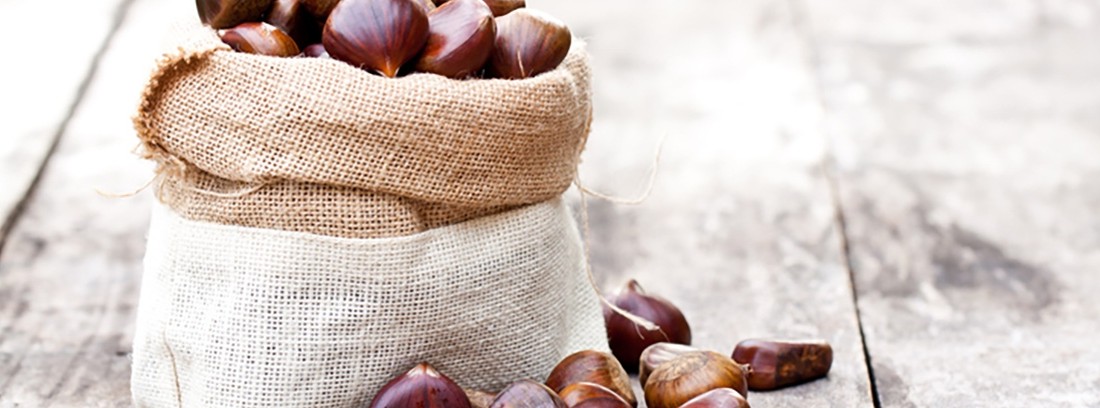Chestnut, source of nutrients

The Chestnut It has sufficient nutritional qualities for us to include it in the shopping cart all year round. The chestnut is the richest dried fruit in complex carbohydrates and, especially, in starch. Contrary to what happens with hazelnuts and walnuts, for example, it provides little fat and a moderate dose of energy. Specifically, it is three times less caloric than hazelnut or almond (100 g of almonds provide about 600 kcal compared to 196 kcal for the same amount of chestnuts) and in terms of its fat content, it is not only low ( 2% compared to 54% for almonds, for example) but mostly polyunsaturated fats, so it is a dried fruit that can be part of the diet of those who must restrict fat without problems. Thus, despite the fact that its consumption has been relegated to an occasional and seasonal whim, we are facing a source of energy as valid as rice, potatoes or bread.
Other virtues of the chestnut
It is worth highlighting the contribution of chestnut fiber, which makes it an ally in case of constipation, but is also well tolerated by delicate stomachs because its fiber does not have the irritating effect of bran.
In addition, it is characterized by its very low sodium content (2 mg per 100 g) making it a suitable food even for hypertensive people. On the other hand, it is very rich in potassium and this makes it perfect for people who take diuretics, who have cardiovascular problems and, in general, for everyone. Of course, if it comes to boiled chestnuts, the dose of this mineral will be much lower.
Iron and calcium are also present in the chestnut, as well as the, which will make the first one absorbed more easily. The contribution of is very remarkable, something to keep in mind because it is a vitamin present mainly in vegetable fats and whose intake is not always adequate. Especially in the case of low-calorie diets, where fats are often suppressed, reaching optimal levels is not so easy.
How to take them?
When it comes to taking it, its low sodium content makes it possible to combine it with sweet and salty foods. In addition, it can be consumed in several ways:
- Boiled and pureed: it is an original and nutritious garnish for all types of meats. Dressed with oil and a little salt, it combines perfectly with red meat, poultry and even the typical roast-beef.
- Baked: it can be a healthy snack, without fat and suitable for everyone. Especially for children since it constitutes a much healthier snack than the classic piece of industrial pastries. Always bearing in mind that we should not ingest the blackened parts and that they must be allowed to cool, since hot chestnuts can be quite indigestible.
- Toasted and crushed: it is a great accompaniment to fruit salads, yogurts, soups and even ice cream.
Did you know…
- In other times the chestnut was considered the bread of the poor and in Corsica, it even came to replace wheat.
- Raw have more nutrients, but can be eaten boiled like potatoes or roasted.
- A balanced portion of chestnuts is considered the equivalent of 150-175 g without peeling.
Who is it suitable for?
The chestnut can be part of everyone's diet, but it is especially suitable for:
- People who follow a diet low in salt, due to its minimal amounts of sodium (almonds have 10 times more sodium), making it suitable in case of hypertension or heart ailments.
- Liver, biliary or digestive problems, since it has vitamins and energy but very low doses of fat.
- Underweight or inappetent children, as it constitutes a healthy, smooth snack that provides energy without adding saturated fat to the diet.
- In case of fatigue, convalescence or if a great physical exhaustion is carried out because they provide stable and progressive energy thanks to their complex carbohydrates.
- Dieters, as it is a low-calorie, low-fat nut with a healthy lipid profile, providing interesting nutrients and energy.
Buying and conservation advice
It is important to feel them well and check that they are hard, in addition to checking that they have a deep brown color. They can be stored at room temperature for a couple of months and if you want to keep them longer, it is best to peel them and store them in the fridge. To make it easier for you, soak and bake them. When the peel opens, turn off the oven and once it is at room temperature, you can peel them.
Chestnut cream
Ingredients:
- 1 kg of chestnuts
- 250 ml milk
- 80g butter
- Salt
preparation:
Boil the chestnuts in a pot with plenty of water and a pinch of salt. After about 20 minutes remove them and, once cooled, remove the skin.
Place the peeled chestnuts in a bowl and pour the hot milk over them. Add the butter and mix well with the help of a mixer. Add one more pinch of salt.
You can place it in airtight glass jars and keep it in the fridge. It is ideal to use as a jam or to accompany a meat dish.
Related topics
- It is the dried fruit richest in complex carbohydrates.
- Compared to other nuts, it provides little fat and a moderate dose of energy.
- Baked, roasted, or boiled and mashed it is delicious.
Carlota Mañez Arisó
Diploma in Nutrition and Dietetics
(Updated at Apr 14 / 2024)